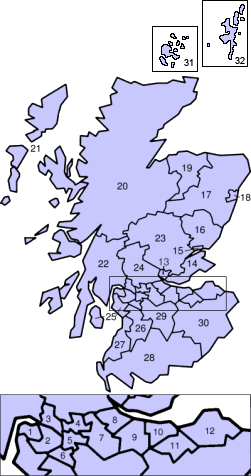Local government in Scotland facts for kids
Local government in Scotland helps manage daily life in different areas. It's like having a local team that looks after things close to home. Scotland has 32 of these local teams, called Councils.
Each Council has people called councillors. These councillors are chosen by voters every five years. They work to make decisions for their local area.
Councils get most of their money from the Scottish Government. This money helps pay for many services. Councils also get some money from a local charge called Council Tax. This tax is set by the Council itself.
All the Scottish Councils work together through a group called the Convention of Scottish Local Authorities (COSLA). This group helps them share ideas and speak with one voice.
Contents
The Story of Local Government
How it Started
The idea of local government in Scotland goes way back. It began with areas called shires. A sheriff was in charge of each shire. They were like early local leaders.
King Malcolm III and his sons, especially David I, helped set up these shires. They wanted to create a more organised system across the country.
Over time, shires started doing more than just legal work. In 1667, people called Commissioners of Supply began collecting taxes. They also took on other local duties. Later, in 1858, police forces were set up in each county.
Some towns, called burghs, had their own special rules. They often managed their own affairs.
Modern Changes
Between 1890 and 1975, local government in Scotland had different levels. There were county councils and smaller groups like parish councils. Later, parish councils were replaced by larger district councils. Some big towns also had their own councils.
In 1975, a new system was introduced. Scotland was divided into large Regional Councils and smaller District Councils. This meant two levels of local government. However, three island areas – Western Isles, Shetland, and Orkney – had special councils that did both jobs.
Then, in 1996, the system changed again. The big Regional and District Councils were replaced by 32 new unitary authorities. This means each council now handles all local services in its area. Some of these new councils are very large, like Highland. Others are smaller, like Clackmannanshire.
Scotland's Council Areas
Council Elections
In 2007, a new way of voting was used for local elections in Scotland. It's called the single transferable vote. This system often means that no single political party wins enough seats to be fully in charge of a council.
After the 2007 elections, most councils did not have one party in control. This means different parties often have to work together to make decisions. Only a few councils, like Glasgow and North Lanarkshire, were controlled by one party (Labour). The island councils of Orkney, Shetland, and Na h-Eileanan Siar continued to be led by councillors who don't belong to a political party.
You can find more details about these elections on the page Scottish council elections, 2007.
Community Councils
Community councils are groups that speak up for local people. They help make sure that the voices of the community are heard. Local authorities must ask community councils for their ideas on things like new buildings or local projects.
However, community councils don't directly provide services like schools or roads. They are more about representing local interests. In some areas, they work very well to improve their local community. People who stand for election to a community council cannot represent a political party.


